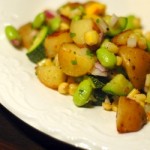
Probably the most assertive and controversial item, corn appears as overflowing piles of ears, husk and silk at the farmer’s market during the transition from spring to summer.
The ambiguity of corn as a starch and not a vegetable might present a conundrum to some, but is easily solved by focusing on its content and flavor incorporation to choice recipes. You will find corn in your recipes not only as a whole food but also its processed counterparts including high fructose syrup, powdered starch, alcohol or meal.
I say that corn is controversial because of the growing contempt of processed corn goods present in most of our packaged foods. It is a topic so pertinent, Michael Pollan dedicates an entire third of his opus, The Omnivore’s Dilemma, delineating it as an industrial commodity and the genetic manipulation therein (GMO’s).
I have not banned the use of processed corn products in my kitchen; instead, I buy organic ensuring that I am avoiding any products that have been engineered in a lab. I use high fructose corn syrup (better known as Karo) in my sorbets to give it a smoother texture, cornstarch is used to thicken sauces and stabilize pastry creams, corn based alcohols find their way into my diet some way, and lastly corn meal is used for breads, muffins and polenta.
As a whole food, I use corn in as many recipes as I can when it has reached its peak sweetness. Primarily, I like to throw the ears on the grill to slightly char the kernels before cutting them from the cob. The high heat from the fire not only imparts a smoky flavor and nice aesthetic but also caramelizes the natural sugars, enhancing the sweetness without overcooking.
I use the charred al dente kernels in salsas and salads, alone with some butter and salt or as an addition to potato dishes. In the recipe here, the corn is added to both potatoes and fresh vegetables furthering its ambiguity and enhancing the flavor profile.
 Corn’s ambiguity is present in its sexuality and reproduction, too. The hermaphroditic corn stalk contains both male (tassels on the top) and female parts (the ears and silks). Even though it can self-pollinate, it does a better job in a field with a lot of other stalks much like a great big corn orgy.
Corn’s ambiguity is present in its sexuality and reproduction, too. The hermaphroditic corn stalk contains both male (tassels on the top) and female parts (the ears and silks). Even though it can self-pollinate, it does a better job in a field with a lot of other stalks much like a great big corn orgy.
What I find most interesting about corns’ reproduction is that each strand of silk that is protected by the husk translates to an individual kernel of corn. The silk strand is actually a tiny tube that, once the tip is contacted by a male gamete, ushers the cell to its base (some 6 inches) for the growth of the corn kernel.
I cannot pretend to be able to give you all the facts I wish I could here, but hope that this column’s personification of an American staple will spark new interests. Though ambiguousness, assertion and controversy are words not commonly associated with food, they are very descriptive for corn’s infiltration of our diets.
Is corn the Lady Gaga of our tables? Working its way into all the crevices of our daily routines? Not being able to turn around without seeing the decked out persona? Perhaps, but I’m certain that preparation, study and consumption are probably the simplest ways to find out.
bobby’s recipe
Summer vegetable succotash
I am truly inspired by this dish because of the full variety of food types present in what, at first glance, would appear to be a vegetable specific side dish. The inclusion of edamame instead of the traditional lima bean, pack the dish with protein while the corn and potato distribute your meal’s starch allowance.
I like to serve this dish as a side with southwestern-style dry rubbed pork chops or a spicy grilled chicken dish but it is also perfectly suitable to stand alone as a main for a vegetarian or vegan meal once the pancetta is omitted.
5 red potatoes
2 tablespoons of olive oil
3/4-inch slice of pancetta
Three small zucchinis
Kernels from 3 ears of corn
14 ounces thawed, shelled edamame
5 sprigs of thyme
1/2 cup finely diced red onion
 Cut the potatoes into one-inch cubes and boil for 10 minutes. Allow to cool. Sauté the potatoes in the olive oil over high heat, turning occasionally, until browned. Set aside.
Cut the potatoes into one-inch cubes and boil for 10 minutes. Allow to cool. Sauté the potatoes in the olive oil over high heat, turning occasionally, until browned. Set aside.
In a 12-inch skillet, sauté the pancetta, cubed to 1/4 inch, until browned. Remove the pancetta with a slotted spoon, reserving the grease, and set aside.
Slice the zucchinis in half-length, then slice into 1/2-inch thick half-rounds (width wise). In the pancetta grease, sauté the corn kernels and the zucchini over a high heat until just browned (about 7 minutes). Add in the thawed, shelled edamame and the reserved potatoes to the pan. Stir gently and cook until all the contents have been warmed then remove from the heat.
Stir in the thyme leaves and diced red onion. Serve immediately and garnish (sparingly) with the pancetta.
For an added flair, hollow a large heirloom tomato and make a slice down one side. Spoon the succotash into the tomato cup and allow to overflow from the slit.










